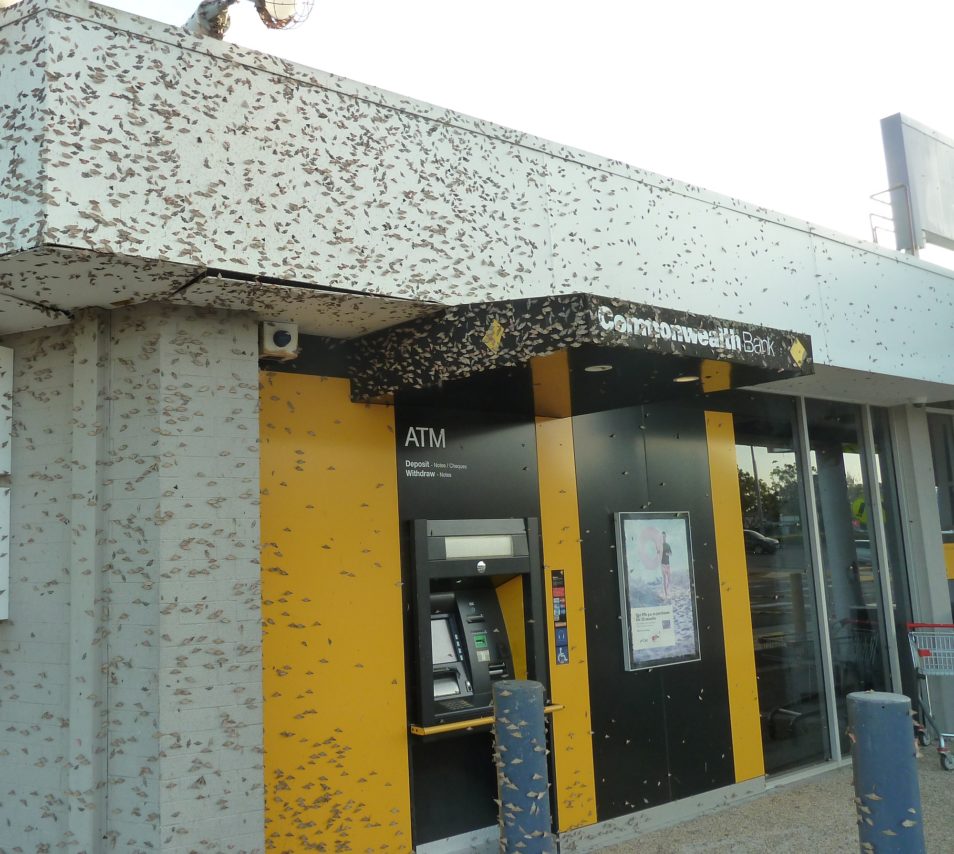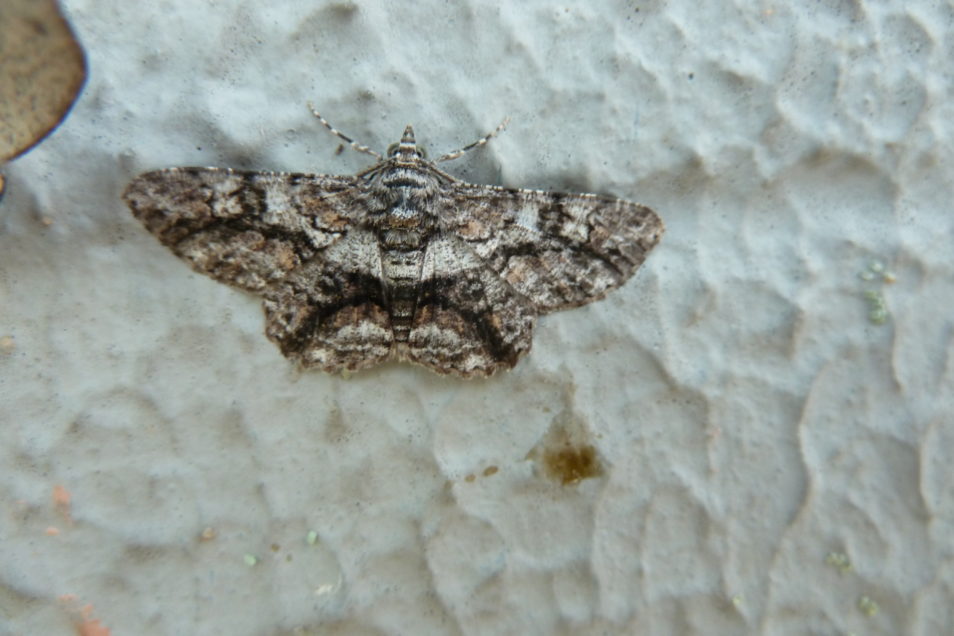
Moths drawn to this Commonwealth Bank branch in Brisbane are part of a population boom following recent rain. Photo credit: Don Sands
Huge numbers of moths are milling around, and settling on, the Commonwealth Bank branch at Kenmore in Queensland. The moth swarm phenomenon has attracted the interest of local resident Don Sands, an honorary fellow of our Australian National Insect Collection. Let’s just say they aren’t there to cash in a cheque.
“The moths are attracted by the lights on the building in combination with the yellow wall at the bank, especially at night,” Don said. “They also settle on nearby objects and walls of various colours and have done so for more than a week.”
The yellow paint colour of the bank happens to be a very attractive shade to insects. It’s similar to the yellow sticky traps Don has used many times to catch moths and other insects for research. Some insects may be attracted to yellow for different reasons, including if it matches their food source, such as flowers.

Moths typically rest with the upper side of their wings visible, while butterflies hold them closed above their body, hiding the often colourful upper side of the wings. This moth belongs to the species Cleora displicata. Photo credit: Don Sands
Moth population inflation
Queensland’s huge number of moths reveal the diversity of moth species in Australia. The current population explosion and mass migration of both moths and butterflies is due to recent rainfall.
In times of drought, moths and butterflies press pause on their life cycle by entering a state known as diapause. This usually occurs at the pupal stage. Not all moth caterpillars spin a cocoon, many pupate between leaves tied together or in the soil. Moth pupae can stay frozen in time for up to five years, depending on the species, before emerging as adults.
“The moth abundance and their emergence has been triggered by prolonged drought followed by rain,” Don said. “Numbers are abnormally high due to suppression of parasitoids last spring and by rain breaking diapause of inactive stages,” he said.
Parasitoids are insects, mostly wasps but also tachinid flies, that parasitise moths and butterflies. Their tale is similar to the very hungry spider wasp, a wasp that parasitises spiders.
“In my opinion small parasitic wasps have suffered more from the drought than moths, meaning their normal ecological role of keeping moth numbers under control has been thrown into imbalance,” Don said.

Most of the moths on this bollard are the species Antictenia punctunculus. The larvae of this species, which feed on eucalypts. Photo credit: Don Sands
In the counting house
We’ve counted at least 15 different species of moths on the bank. They include agricultural pests such as Helicoverpa armigera and some species that are new to science.
This is not surprising. Only around half of Australia’s moths and butterflies have been described and named. It highlights the ongoing need for taxonomists and ecologists who can describe and protect biodiversity and tell pest moths apart from native species.
“Most of the moths on the bollard beside the ATM are Antictenia punctunculus in the family Geometridae,” Ted Edwards of our Australian National Insect Collection said. “There is also an outbreak of the larvae of this species. The larvae feed on Eucalyptus and I have not heard of an outbreak of such numbers of this species before.”
Other species Ted spotted on this bollard are Cleora displicata, which is also in the Geometridae family, and a moth from the family Eutelliidae.


23rd April 2020 at 9:25 pm
I have had so many moths in my home, all different sizes and patters. Not sure why they are coming though.
2nd April 2020 at 7:34 am
Can you tell me more about the poinciana looper moth please?
also, what are the little yellow moths in abundance?
22nd April 2020 at 2:37 pm
Hi there! We highly recommend our Atlas of Living Australia for more information on flora and fauna. We even found this page on the poinciana looper moth you were interested in: https://bie.ala.org.au/species/urn:lsid:biodiversity.org.au:afd.taxon:84a75047-d5ff-4d51-b8bd-e5afb586c412.
Thanks,
Georgia
Team CSIRO
10th March 2020 at 9:48 am
If lepidoptera can put their life cycle on hold during the pupal stage, would it be better to transport or store economically useful insects such as silkworms as pupae?
17th March 2020 at 8:55 am
Hi Jill,
Our scientists are generally not able to assist with requests for an expert opinion, as their main activity and priority is to carry out their research, which means they are often off-site or time-restricted by project management requirements.
In this instance you might try these alternatives:
• https://expertconnect.global/
• https://theconversation.com/experts/
• https://www.expertguide.com.au/
Thanks,
Georgia
Team CSIRO
9th March 2020 at 12:57 pm
Happening all over. In Noosa Hinterland, one of our two Cassia queenslandicas has been totally defoliated by hundreds of Lemon Migrant larvae and the only predator I’ve seen was one very fat mantis. Birds seem to ignore them too, so maybe taste bad? An adjacent Cassia q is also a busy host site, but not as denuded for some reason… maybe fewer eggs, later hatching, who knows. The adults have been boiling off in tens and scores for past few weeks.
8th March 2020 at 11:07 am
Does this moth bonanza include bogong moths whose absence from Kosciuszko last year was disastrous for mountain pygmy possums?
17th March 2020 at 8:57 am
Hi Murray, we hope so! We encourage everyone to support these species by recording sightings using this citizen science website: https://www.swifft.net.au/mothtracker/
Thanks,
Georgia
Team CSIRO